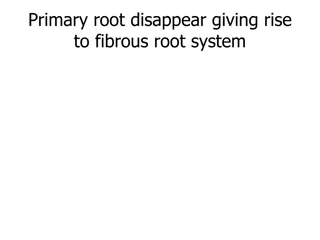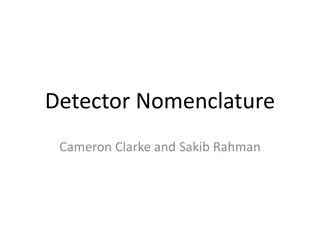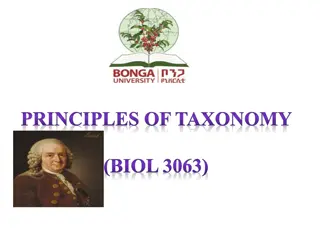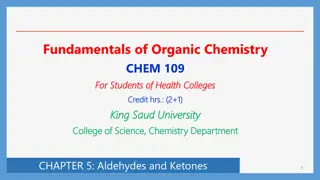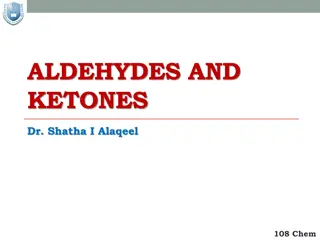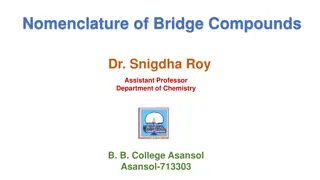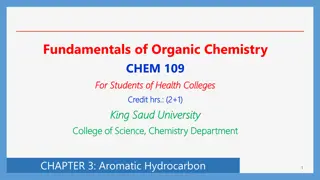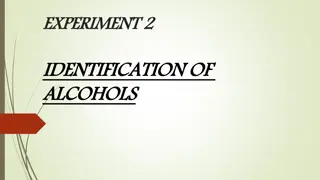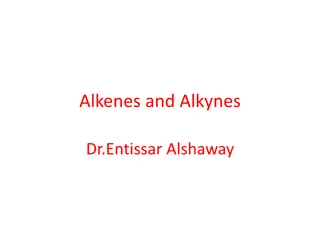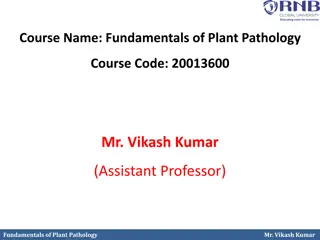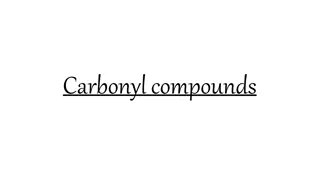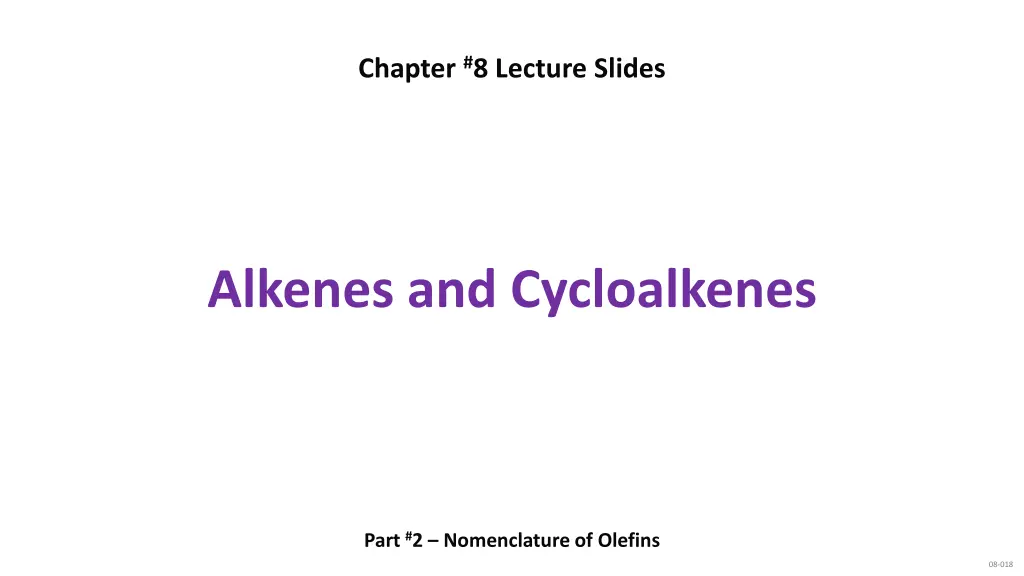
Understanding the Nomenclature of Alkenes in Organic Chemistry
Learn about the systematic nomenclature of alkenes, including rules for naming based on chain length, location of double bonds, and stereochemistry. Explore how to apply IUPAC guidelines for naming organic compounds, incorporating E/Z descriptors for stereoisomers.
Download Presentation

Please find below an Image/Link to download the presentation.
The content on the website is provided AS IS for your information and personal use only. It may not be sold, licensed, or shared on other websites without obtaining consent from the author. If you encounter any issues during the download, it is possible that the publisher has removed the file from their server.
You are allowed to download the files provided on this website for personal or commercial use, subject to the condition that they are used lawfully. All files are the property of their respective owners.
The content on the website is provided AS IS for your information and personal use only. It may not be sold, licensed, or shared on other websites without obtaining consent from the author.
E N D
Presentation Transcript
Chapter #8 Lecture Slides Alkenes and Cycloalkenes Part #2 Nomenclature of Olefins 08-018
Nomenclature of Alkenes 1. Our textbook despite being published in 2021 does not reflect the updated IUPAC guidance from 2013 regarding the systematic nomenclature of olefins. a disappointed IUPAC apparatchik Failure to adopt international standards is why Americans still use inches, yards, miles, ounces, and pounds, among other antediluvian units 08-019
Nomenclature of Alkenes 2. Alkenes are named based on the longest continuous chain of carbon atoms in the molecule, regardless of whether the chain contains the double bond or not. If the chain includes the C=C bond, replace the ane suffix from the parent alkane hydrocarbon with ene. this is a hexene this is a hexene this is a pentane not a butene Note: Klein s 4th edition (your textbook, published in 2021) perpetuates the outdated rule of selecting the parent chain as the longest chain of carbon atoms that includes the bond. This used to be the IUPAC preference before 2013. 08-020
Nomenclature of Alkenes 3. When the parent chain includes both carbons in the double bond, number the chain starting from the end that gives the start of the double bond the lower locant number. Insert the locant number directly in front of the ene suffix. hex-1-ene not hex-5-ene 4-ethyl-2,3-dimethylhex-3-ene not 3-ethyl-4,5-dimethylhex-3-ene In case of a tie, apply the nomenclature rules we already know as the tiebreakers: 1. number the chain to give the lower locant to the first substituent (and so on ) 2. number the chain to give the lower locant to the first substituent that comes earliest in the alphabet It is not uncommon to encounter the locant for the double bond in front of the name of the parent chain: 1-hexene 2,5-dimethyl-2-hexene 08-021
Nomenclature of Alkenes 4. Notice how we simply incorporate these new rules for alkenes into all the rules of nomenclature we learned for alkanes and alkyl halides. 2,2-difluoro-4-propylhept-3-ene 3-ethyl-8-methylnon-3-ene not 7-ethyl-2-methylnon-6-ene (4S)-4-ethyl-5-methylhex-1-ene not (4S)-4-isopropylhex-1-ene (2R)-2-bromo-4-ethylhex-3-ene not (5R)-5-bromo-3-ethylhex-3-ene 08-022
Nomenclature of Alkenes 5. Recall that C=C double bonds in which each olefinic carbon atom is substituted with two different groups can exist as a pair of diastereomers. 6. We differentiate these stereoisomers with E/Z descriptors added as prefixes. (3E)-3-methylhept-3-ene (3Z)-3-methylhept-3-ene If the higher priority groups (using the Cahn Ingold Prelog system) on each carbon atom are on opposite sides of the double bond, the descriptor E is used. If the higher priority groups are on the same side , the descriptor Z is used. 08-023
Nomenclature of Alkenes 7. In cases where each carbon atom of the C=C bond is only monosubstituted, it is acceptable to use the descriptors cis- and trans- (2E)-pent-2-ene trans-pent-2-ene trans-2-pentene (2Z)-pent-2-ene cis-pent-2-ene cis-2-pentene (3E)-3,4-dimethylhept-3-ene not trans-3,4-dimethylhept-3-ene certainly not cis-3,4-dimethylhept-3-ene (3Z)-4-bromo-3-methylhept-3-ene 08-024
Nomenclature of Alkenes 8. When the parent chain of an alkene does not include the double bond, it will be included in the name of a substituent of the parent chain. (6S)-6-(2-methylpent-4-en-2-yl)dodecane 9.Alkene-containing substituents are named as alkenes, except after you identify the longest chain of the substituent, you number it from the end that gives its point of attachment to the parent chain the lower locant number. The substituent name is made by dropping the final e, then appending the locant of the point of attachment followed by yl. a but-3-en-1-yl group a but-3-en-2-yl group a but-2-en-2-yl group a but-1-en-2-yl group 08-025
Nomenclature of Alkenes 10. Groups attached via a double bond to the parent chain are named as ylidenes. a methylidene group a butan-1-ylidene group a butan-2-ylidene group sometimes seen as its common name: a methylene group 5-(pentan-3-ylidene)decane 08-026
Nomenclature of Alkenes 11. IUPAC allows common names for some alkenes and alkene-containing substituent groups vinyl group but ethenyl preferred ethylene allyl group propylene but ethene preferred but prop-2-en-1-yl preferred but propene preferred styrene 4-ethenylheptane preferred also 4-vinylheptane not 3-propylhex-1-ene also vinylbenzene but ethenylbenzene preferred 08-027
Nomenclature of Cycloalkenes 1. Cycloalkenes are compounds with a C=C bond between two carbons in a ring. 2. Cycloalkenes are named by numbering the ring such that the C=C bond is between C1 and C2. cyclohexene not cyclohex-1-ene 3,3-dimethylcycloheptene not 1,1-dimethylcyclohept-2-ene not 7,7-dimethylcycloheptene 5,5-dichloro-1-methylcyclopentene not 5,5-dichloromethylcyclopentene not 1,1-dichloro-2-methylcyclopent-2-ene The locant 1 for the position of the C=C bond in a cycloalkene is omitted when alone as it is implied. 08-029
Nomenclature of Cycloalkenes 1. When contained in small rings fewer than 8 atoms it is assumed all double bonds are cis- with respect to the ring sides if no E- or Z- descriptor is given. 1-methylcyclobutene (1Z)-1-methylcyclobutene 1-bromocyclobutene (1E)-1-methylcyclobutene 2. Incorporate these rules for cycloalkenes with the other rules for nomenclature we have learned. methylidenecyclohexane (1E,4S,8S)-4-chloro-8-methyl-1-(pent-1-en-2-yl)cyclooctene 08-029
Nomenclature of Polyenes and Cyclopolyenes 1. Compounds with multiple C=C double bonds are called polyenes. 2. When multiple C=C bonds appear in the longest chain, replace the ne suffix from the parent hydrocarbon with diene (for 2), triene (for 3), etc. cycloocta-1,3,6-triene also 1,3,6-cyclooctatriene not cycloocta-1,4,6-triene (3R)-3-methylhexa-1,5-diene 08-030
Nomenclature of Polyenes and Cyclopolyenes 3.If there is a tie for longest chain in a polyene, choose the chain with the most double bonds. (3S,4E)-3-ethylocta-1,4-diene not (3S,4E)-3-ethenyloct-4-ene 08-031
Practice Problem: Olefin Nomenclature Q: Provide a name acceptable to IUPAC for the following compound. A: (2R,3E)-2-bromo-4-(2-fluoroethan-1-yl)hept-3-ene P08-01-01


